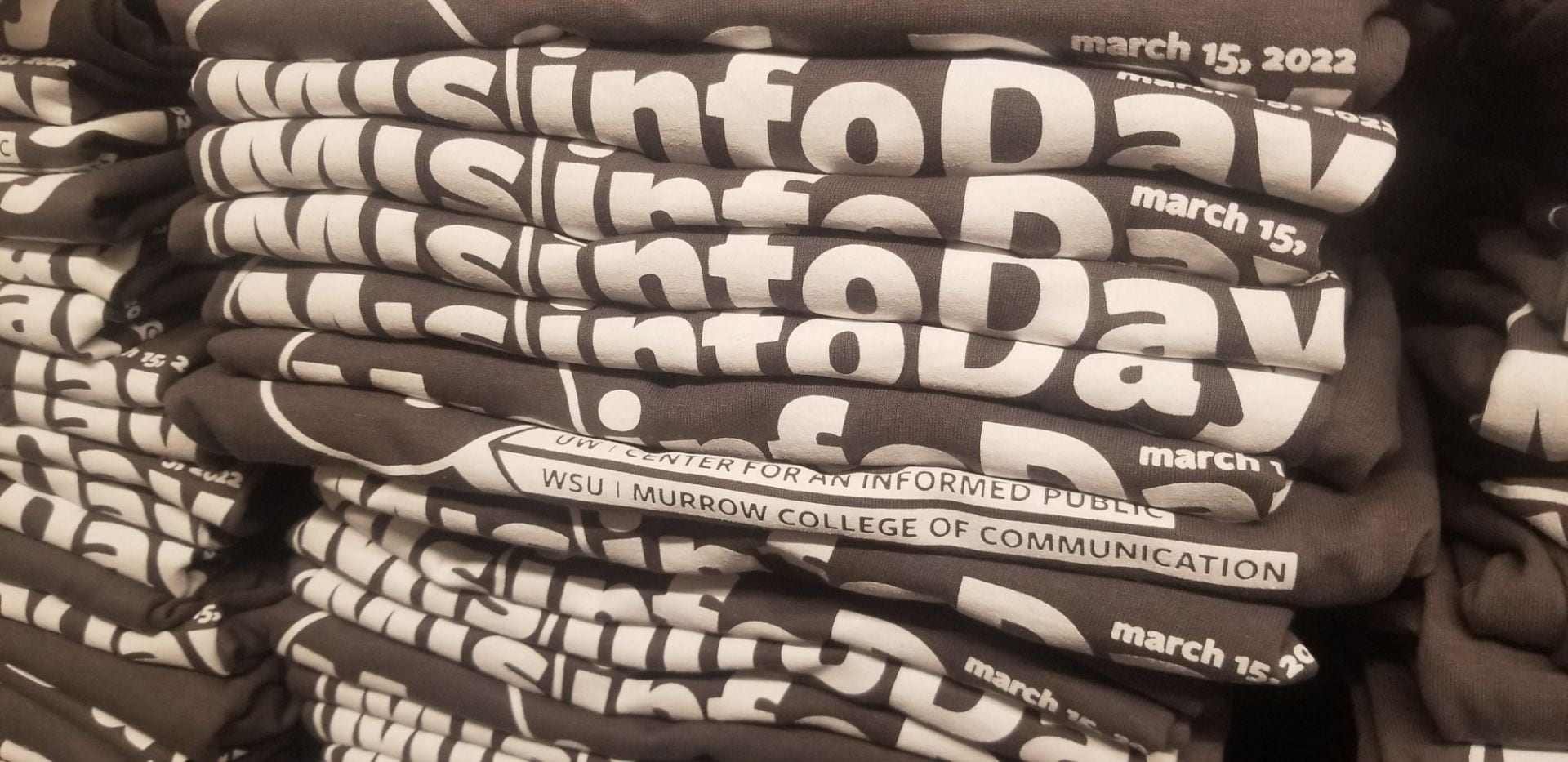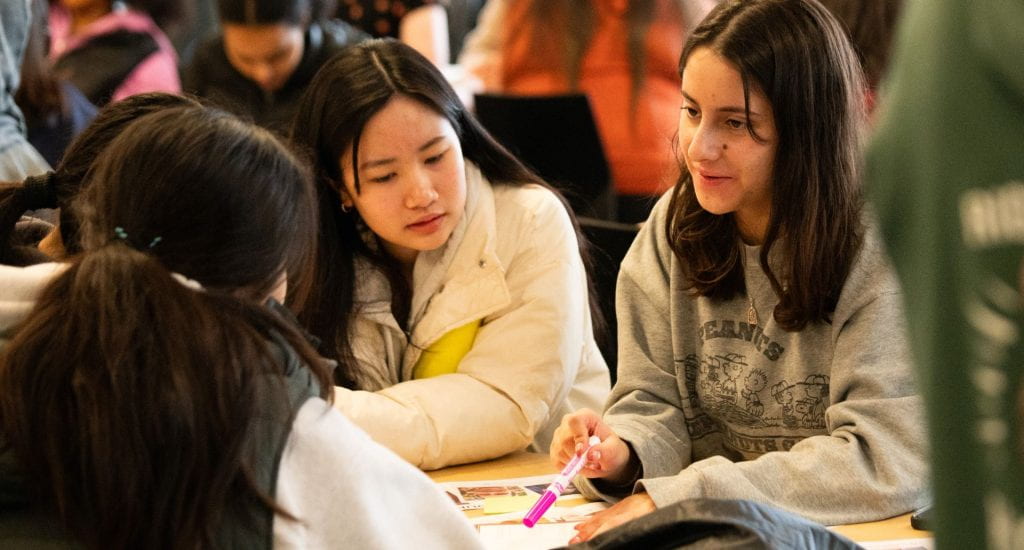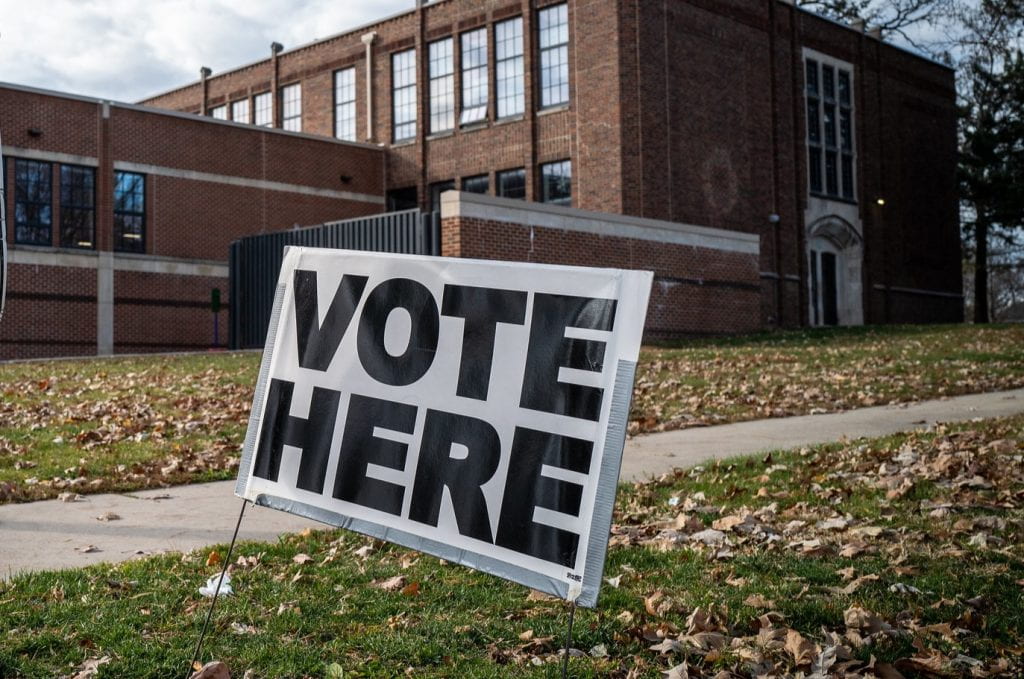By Michael Grass
More than 1,300 students from more than 70 schools across Washington state and beyond participated in recent MisinfoDay 2022 educational activities planned and co-presented by the University of Washington’s Center for an Informed Public and Washington State University’s Edward R. Murrow College of Communication through an ongoing statewide educational and research partnership.
The 2022 program, hosted on March 15, included a misinformation-themed escape room game teams of students played, along with eight pre-recorded video workshops facilitated by experts from the CIP, WSU Murrow, UW Bothell and Northwest Public Broadcasting that teachers used in classroom activities and can continue to use as educational resources.
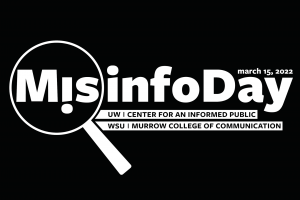 As reporter Nina Shapiro wrote in The Seattle Times in a March 15 feature, MisinfoDay “couldn’t be more perfectly timed, coming during Russia’s misinformation and disinformation (deliberate lies) campaign over the war in Ukraine that shows exactly why students and non-students alike have to stay alert.”
As reporter Nina Shapiro wrote in The Seattle Times in a March 15 feature, MisinfoDay “couldn’t be more perfectly timed, coming during Russia’s misinformation and disinformation (deliberate lies) campaign over the war in Ukraine that shows exactly why students and non-students alike have to stay alert.”
In The Seattle Times feature, Shapiro visited Ballard High School, where teacher Shawn Lee’s classes tested out the The Euphorigen Investigation escape room game — developed through a research collaboration with the CIP, the UW Information School’s Technology & Social Change Group (TASCHA) and GAME Research (GAMER), and Puzzle Break — with his students. Shapiro also highlighted key lessons and ideas from MisinfoDay workshop videos, speaking with MisinfoDay coordinator Liz Crouse, who helped organize the first MisinfoDay in 2019 at the UW Information School; CIP co-founders Jevin West, an iSchool associate professor, and Kate Starbird, a UW Human Centered Design & Engineering associate professor; and CIP postdoctoral fellow Madeline Jalbert.
In Washington’s Tri-Cities area, Northwest Public Broadcasting reporter Dori Luzzo Gilmour interviewed Richland High School librarian Rebecca Dartnall who facilitated MisinfoDay educational activities for students, including the escape room game. The aim is to help students “make sense of the tsunami of information that is crashing into them 24/7. And we need to help equip them with tools about what is fake, what is real, how to gather facts, how to share them,” Dartnall said in the March 15 NWPB segment on MisinfoDay. “We want to help them, just for a little while, to stop and focus on how they gain their information, how they produce information, and how they can do that ethically and responsibly … and still make it a fun day too.”
While the escape room game was played in many classrooms in Washington state that were participating in MisinfoDay, students in New Zealand, through an educational partnership with the U.S. Embassy and library stakeholders in New Zealand, also tested The Euphorigen Investigation game. “Through the Euphorigen Investigation experience, participants can reflect on their own social media behaviors and become more resilient when encountering misinformation,” said Chris Coward, a CIP co-founder and iSchool senior principal research scientist, who has helped lead the development of the game with iSchool associate professor and CIP faculty member Jin Ha Lee.
***
Why we’re all vulnerable to misinformation
Jalbert, who studies social and cognitive psychology, co-presented a workshop, “Why We Fall for Misinformation,” with Starbird that explored the reasons why we’re all vulnerable to sharing and spreading misinformation.
In an interview with KUOW Public Radio’s Kim Malcolm during NPR’s “All Things Considered,” Jalbert shared insights about the psychological aspects of sharing information, including the illusory truth effect, which, Jalbert said, “refers to the phenomenon that merely repeating information makes it seem more true. This occurs for true information and for false information. If you’ve seen something before, you’re more likely to believe it when you come across it again. Before it was ever studied in a lab, demagogues knew that it worked, that just merely repeating something over and over was an effective tactic to spread that belief.”
***
Leading with empathy and patience
Jalbert, Starbird and West joined Hanson Hosein, the founder of the UW Department of Communication’s Communication Leadership graduate program, for a moderated conversation, “How to Talk to Friends and Family Who Believe Misinformation,” which Shapiro, in The Seattle Times, wrote takes a “surprisingly sensitive approach” on a complicated subject.
“Part of the reason for this empathetic approach, the researchers said, is that spewing facts won’t change people’s minds. There’s too much involved, like emotions and ties to others who hold the same beliefs,” Shapiro wrote. “Jalbert said people can also simply forget a fact. What’s better, she said, is to explain how misinformation spreads so that people have more context to hang onto.”
***
Checking claims online
CIP research scientist Mike Caulfield, a digital literacy expert who developed the SIFT method for contextualizing claims and factchecking information online, facilitated a MisinfoDay workshop, “How to Tell If Something You Saw Online is True: Sourcing Quotes,” that teaches students skills for assessing whether quotations shared online were actually said by the person the quote is attributed to.
“Sourcing quotes is one of the toughest web tasks out there,” Caulfield said. “Fake quotes are everywhere online and very often you’ll be using a quote in a paper or a presentation or even something like a college admissions letter. And if someone catches you using a fake quote or something that someone knows, ‘Oh, that person never said that,’ then that is going to ruin your credibility, right?’ … So you should at least try to source the quotes you use …”
In a March 15 interview with KUOW’s “Soundside” program, Caulfield discussed the SIFT method — [S]top, [I]nvestigate the source, [F]ind better coverage, and [T]race claims, quotes and media back to the original context — and also why Russia’s invasion of Ukraine makes it especially important for people to be careful about information and reports from the ongoing conflict. “It’s a series of events taking place in a foreign country, there are language differences, there are sort of complex political dynamics that the average viewer or reader may not be aware of,” Caulfield told KUOW’s Libby Denkmann. “And then of course, you know, there’s just the nature of war, propaganda.”
***
Understanding where to find reliable health information
Two MisinfoDay 2022 workshop videos had health-focused lessons.
In “Making Smart Decisions About Health Information,” WSU professor Erica Weintraub Austin, who directs the WSU Murrow Center for Media and Health Promotion Research, discussed how decisions around health are guided by both logic and emotions, like fear, anger and wishful thinking. A key point: “You need to put logic back into the decisionmaking so you’re using media instead of letting media use your emotions,” Austin said, later noting that “asking questions leads to better informed beliefs and healthier choices that are going to be right for you.”
In “Misinformation During a Global Pandemic: Lessons Learned,” Justin Gill, a nurse practitioner in Everett, Washington and a health policy lecturer at the UW Bothell School of Nursing & Health Studies, discussed the COVID-19 “infodemic” and the challenges misinformation created during the pandemic. Gill offered key tips when trying to assess health-related data and information, including: Knowing the sourcing of the information; knowing that not all data and information are created equal; avoiding “confirmation bias” when considering information about health-related topics online; and understanding that with health information, more often than not, common things happen far more often than uncommon things.
***
Lessons from Journalism
In a MisinfoDay 2022 workshop, “How Journalists Find Truth,” Northwest Public Broadcasting journalist Johanna Bejarano shared insights from the newsgathering and reporting process, including conducting interviews, verifying information and vetting claims being made by people. In one example, Bejarano walked through, step by step, how Northwest Public Broadcasting tried to verify claims made by a county commissioner during a public meeting who said that homeless people from Seattle were being bused and dropped off along a highway in central Washington.
“Can we verify the information? Is there evidence or proof that it happened? What happens when we don’t verify the information? Is it a mistake? Is it possible? Is it true?” Bejarano said, asking a series of questions journalists deal with daily in their work. “We need to find out.”
In a separate video workshop, “Journalism and Democracy,” WSU Murrow assistant professor Jennifer Henrichsen discussed ways journalism is under attack, the core principles that underpin the work of journalists and news organizations and guidance for students interested in pursuing a career in journalism. “We know that journalism happens at a rapid pace but as a reporter, you need to conduct your own reporting to make sure the story is accurate, the sourcing is sound and that the information came from multiple sources,” Henrichsen said when discussing key journalism concepts, including the discipline of verification.
***
Don’t Be Fooled by Deceptive Data
In a MisinfoDay 2022 workshop, “How to Debunk Deceptive Data,” West shared tips and techniques on what to be watchful for “mis- and disinformation that comes wrapped in data and statistics,” including tables, graphs and other data visualizations. “We’re drowning in misinformation, much of it quantitative,” West said.
You can learn more from West’s work on distorted data visualizations through a special Pacific Science Center virtual exhibit, “Uncovering Reality.”
***
Students Help Shape MisinfoDay’s Lessons and Activities
Ahead of MisinfoDay 2022, the CIP and Murrow College helped assemble a Student Advisory Board who met virtually to discuss ideas, lessons and themes that they thought were important and valuable to learn about.
The members of the board for the 2021-2022 school year – Taylan Allison, Shubham Bansal, Norah Rose Dillman, Buggy Eakin, William Hardaway, Braden Kallstrom, Kacee Kearney, Praveena Mahendran, Claire Rogge, Christopher M. Ross, Makenzie Marie Stinson and Erika Tran – represent the following high schools in Washington state: Kamiak High School, Wenatchee High School, Washougal High School, Peninsula High School, Snohomish High School, Eastlake High School, Evergreen High School, Marysville Getchell High School and Interlake High School. (Pictured below, from left: Shubham Bansal, Buggy Eakin, William Hardaway, Kacee Kearney, Christopher M Ross, Makenzie Marie Stinson)
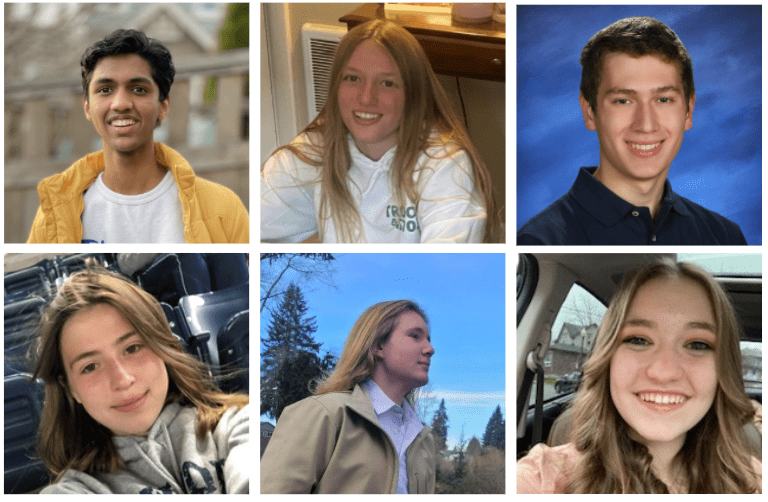
***
Looking Ahead to MisinfoDay 2023
Following a successful MisinfoDay 2022 that reached more students, teachers, librarians and other educators than ever before, the CIP and Murrow College are looking ahead to next year’s programming. Educators interested in planning updates should sign up for the MisinfoDay mailing list.

